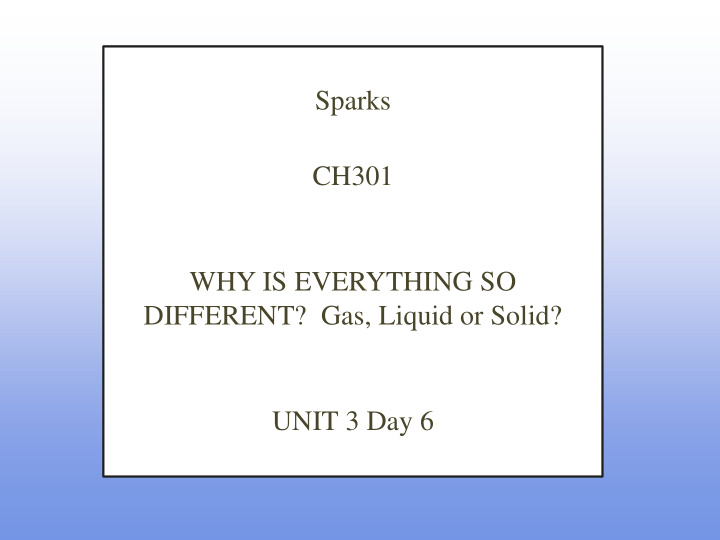



Sparks CH301 WHY IS EVERYTHING SO DIFFERENT? Gas, Liquid or Solid? UNIT 3 Day 6
What are we going to learn today? MO of large molecules Recognize different molecules have different physical properties Classify Intermolecular Forces
POLL: CLICKER QUESTION Most molecules have A. An even number of electrons B. An odd number of electrons C. Equal chance of even or odd
POLL: CLICKER QUESTION Most molecules are A. diamagnetic B. paramagnetic C. Evenly split between the two
What if it is a complicated molecule with lots of atoms How is this tool used.. It is hard to relate the MO to AO None the less the MOs are useful Calculate the lowest energy geometry; Where is the electron density
Other way we use MO, just the pi electrons VB for sigma bonds
MO for the pi bond Where are the electrons? Delocalized around the molecule
Typical MO for organic molecule Almost always diamagnetic HOMO/LUMO Energy gap Light absorption Dyes – homo lumo gap is the color that is absorbed, gaps as a function of structure
MO picture of Ethanol VSEPR and VB to get visual image Predict Polar just from ball and stick
Chemical Composition & Shape Physical Properties? GAS? or LIQUID?
Types of Forces Intramolecular Forces: forces that hold together an individual molecule
Types of Forces Intermolecular Forces: forces between different molecules e.g., forces between: separate CO 2 molecules in CO 2 separate H 2 O molecules in H 2 O
Thought Question! H 2 O(g) + 927 kJ 2H(g) + O(g) H 2 O(l) + 40.7 kJ H 2 O(g) For water, which are stronger: A.The intermolecular forces. B.The intramolecular forces.
What dominates the interaction in condensed phases? What are these forces? Classify forces. Define IMF. REMEMBER TAPE REMEMBER CHARGED ROD and LIQUIDS
INTERMOLECULAR FORCES DOMINATE FORCE IN CHEMISTRY – COULOMBIC
INTERMOLECULAR FORCES DOMINATE FORCE IN CHEMISTRY – COULOMBIC Qualify the word “intermolecular” Boling Point: 1413 °C
INTERMOLECULAR FORCES CONDENSED PHASE – BUT NOT IONIC MOLECULAR CONDENSDED PHASE: MOLECULAR LIQUID OR MOLECULAR SOLIDS “PARTICLE IS A MOLECULE”
Intermolecular forces are based on attraction of opposite charges. Electrostatic forces
In covalent molecules, intermolecular forces are based on the molecule polarity.
REMEMBER: A molecule which is polar overall will have a NET DIPOLE. From now on we refer to this type of molecule as a DIPOLE.
INTERMOLECULAR FORCES: dipole-dipole Attractive force between partial negative end of one molecule and partial positive end of another molecule. Strength depends on distance and dipole moment. E 1 r 3
POLL: CLICKER QUESTION CLICKER QUESTION ALL NONPOLAR COMPOUNDS ARE GASES: A) TRUE B) FALSE
Important Information LM23 posted Extra, non-graded practice: Laude LM Lecture 16 & 17
Recommend
More recommend